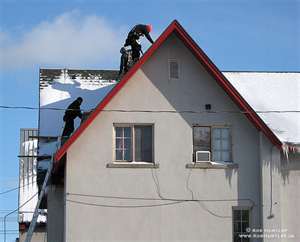How to Repair a Roof In the Winter

Many homeowners are of the impression that if their roof is damaged in the winter, all they can do is to tarp the roof and wait for spring. But that isn’t true! Roof repair can be done in the winter if needed.
Before you grab your shovel and pickaxe and climb onto that 12 pitch skating rink you call a roof, you might want to read some of the suggestions that we at Roofing Tutor have learned over the years. In this Roofing Repair Guide we will discuss the special tools, materials and roofing safety concerns you should be aware of before you take the leap into winter roof repair.
Taking Extra Care in Winter Roofing Work
Whether you hire a professional roofer or do the work yourself, you want to make sure that you plan ahead for safety even if you are just looking over the condition of your roof before you decide what to do. Get a sturdy extension ladder in good condition.Read more about ladder safety.
Find a helper or two to hold the ladder in place while you climb it. Ladder placement is critical in the winter months. If there is snow on the ground, shovel it away so that the ladder rests on bare ground. Clear the rungs of snow or ice and your boots as well. Make sure to extend the ladder several feet above the edge of the roof for safer access to the roof. For a great review of winter ladder set up read Winter Ladder Safety Tips
Ice Dams Any Roofs Nightmare
The most common problem folks face during the winter is ice dams. If there is ice on the roof and it can be cleared, do so. This can be done by several methods. Electric tape works well but it must be applied before the winter season begins., a pickaxe works well with risk to further damage to your roof. Using salt on the roof edge may be the safest and easiest way.
If you have never heard of using your wifes old pantyhose on your roof believe me it works. It is recommended that your bride not still be wearing them. It is a matter of filling the pantyhose with “Ice Melt”, which contains a blend of calcium chloride and rock salt or any deicing salt (found at the local hardware store) you then lay the legs perpendicular to the ice damn. I have to admit many folks say this doesnt work like Reubens Blog but I have used this trick many times with good results and a few giggles from the neighbors. If you are not able to safely remove the ice then it is strongly suggested you contact a professional roofer right away.
Special Materials for Winter Roof Repair
If you plan to replace shingles in the winter, it can be done but you have to add something to bond the shingles together. You nail shingles to the roof, of course, but each shingle has a tar strip on it that causes it to stick to the shingle that overlaps it. The purpose is to keep the shingle tabs down in high winds. Shingles that aren’t stuck to one another are very susceptible to damage in winter winds. The tar strip needs to be about 60F to activate.
In the winter, a dab of roofing cement or tar should be added to each shingle to bond them together until the tar strip is activated in warmer weather. Keep the products indoors until you are ready for them so that they will be malleable in cold temperatures.
There are also rubberized liquid products that are suitable for winter repairs. These products seal in winter and are elastic enough so that they won’t shrink in very cold weather, causing gaps in the materials or causing it to separate from shingles. That won’t happen with these specially formulated products. Keep them inside too, until the moment they are needed on the roof.
Hot tar is also used in the winter to seal gaps and hold roofing material together. And that leads us to the tool section for winter roofing.
Before attempting this project on your own you might want to read what Bruce over at Hammerzone has to say about winter re-shingling
Special tools for Winter Roof Repair
If you are doing the repairs yourself and are using tar, a torch will come in handy as you get it hot enough to adhere to the roof and to roofing material. In addition, a torch may be used in activating the tar strip on asphalt shingles, but take care that you don’t damage the shingle while passing the torch over it. You may have to practice a bit to get the technique right or simply use roofing cement.
Summary
Before you tackle winter roof repair yourself analyze the situation and honestly decide if you have the knowledge and expertise to do the job yourself. It is less costly to hire a professional at the beginning then in the middle of a mistake. If you decide the project is within your range of skill gather your materials and tools and devise a plan of attack. Identify the damaged roofing material and clear it of snow and ice. Get others to help, take extra safety precautions, and dress appropriately to be able to work warmly and comfortably, and take warming breaks if needed.

